Technology
Chemical Vapor Deposition (CVD)
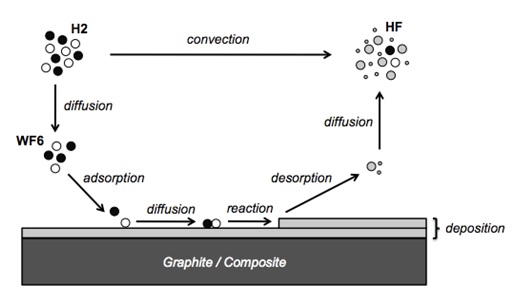 Chemical Vapor Deposition (CVD) uses the selective application of heat to produce high quality and high-density material layers. CVD technology corresponds to the chemical reaction in vapor between one or more compounds (precursors) resulting in a solid deposit to a substrate. The vacuum chamber where the reaction occurs is called the reactor. At Acerde, induction is used to selectively heat the substrate to provide the energy necessary for reaction activation. The reaction products, also gaseous, are evacuated by the gas flow through the reaction chamber.
Chemical Vapor Deposition (CVD) uses the selective application of heat to produce high quality and high-density material layers. CVD technology corresponds to the chemical reaction in vapor between one or more compounds (precursors) resulting in a solid deposit to a substrate. The vacuum chamber where the reaction occurs is called the reactor. At Acerde, induction is used to selectively heat the substrate to provide the energy necessary for reaction activation. The reaction products, also gaseous, are evacuated by the gas flow through the reaction chamber.
The main CVD process parameters are the temperature, the reaction chamber pressure, the precursor gas flow. The substrate finish and cleanliness are also key parameters to drive uniform and regular growth of the deposited layer.
The CVD process allows high purity deposition onto a large selection of substrate materials, including complex shapes and large sized pieces. Complex compounds such as oxides, nitrides and carbides can be deposited by CVD. Moreover, it’s possible to deposit refractory materials like Tungsten at low temperatures relative to their melting temperature.
The following table shows the benefits of CVD vs. other deposition techniques such as Physical Vapor Deposition (PVD) and Vacuum Plasma Spray (VPS):
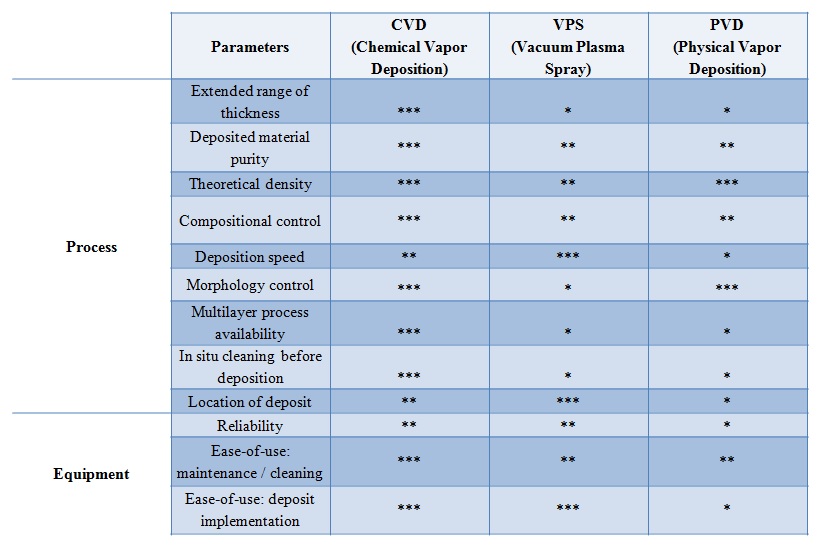
Tungsten
Tungsten has the highest melting temperature of all refractory metals (3422°C). Because of its high hardness, it is difficult to form, and the most common manufacturing technique is powder metallurgy. Tungsten can however be easily deposited as thin film with CVD using the common gaseous precursor, Tungsten Hexafluoride WF6.
Pure Tungsten is used to produce filaments of incandescent light bulb, electronic switches, elements able to produce X-rays (as X-ray targets), etc. We can also find it in alloys and super alloys, such as tungsten steel and cemented carbides, used to produce cutting tools nd wear coatings.
In some cases, such as for X-ray anodes manufacturing, Tungsten is mixed with Rhenium to improve alloy’s ductility, high temperature resistance, corrosion resistance and tensile strength.
Tungsten-Rhenium Deposition By CVD
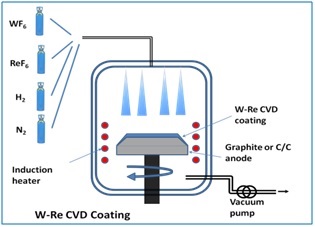 To deposit a tungsten-rhenium alloy, two precursors are used: Tungsten Hexafluoride (WF6) and Rhenium Hexafluoride (ReF6). The chemical reactions which occur on the substrate surface are the following: Dihydrogen being the carrier gas:
To deposit a tungsten-rhenium alloy, two precursors are used: Tungsten Hexafluoride (WF6) and Rhenium Hexafluoride (ReF6). The chemical reactions which occur on the substrate surface are the following: Dihydrogen being the carrier gas:
WF6 + 3H2 → W + 6HF
ReF6 + 3H2 → Re + 6HF
ACERDE Tungsten-Rhenium deposits can range from 1µm to 1mm.
Rotating Targets And X-ray Tubes
The X-rays
X-rays are high frequency electromagnetic waves whose wavelength is between 0.1nm and 10nm. Invisible to the eyes, this ionizing radiation is produced by the abrupt deceleration of the incident electrons when they arrived on the anode (Bremsstrahlung). The initial kinetic energy of electrons is transformed into heat (99%), and X-rays (1%).

The tube
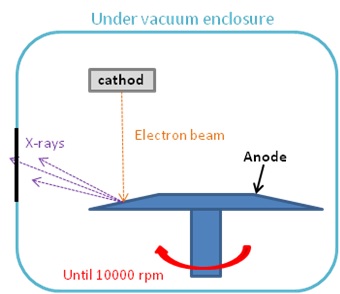 X-ray tubes are an essential component for multiple types of medical imaging. It’s integrated into angiography, mammography, computed tomography and cardiology equipments as well as for other non-medical applications such as non-destructive inspection and security checks.
X-ray tubes are an essential component for multiple types of medical imaging. It’s integrated into angiography, mammography, computed tomography and cardiology equipments as well as for other non-medical applications such as non-destructive inspection and security checks.
There are several kinds of tubes but the principle is generally the same: in a vacuum chamber made of glass or metal, called the insert, an electron beam is directed from the cathode to the anode and the interaction between those electrons and the target material will produce X-ray radiations. The anode angle will control the X-ray output, which is directed toward the patient or the object to be inspected. This insert is placed into a shielded enclosure filled with cooling oil. The X-rays leave the tube through a X-ray transparent window, commonly made of Beryllium.

The target
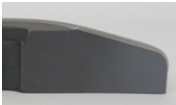 The target, is one of the primary compounds of an X-ray tube in terms of both cost and complexity. It consists on a disc shaped substrate, The cathode facing surface is coated with a tungsten layer to form the track area. The target must be made of a high temperature resistant material due to significant heating of the entire anode during ebeam bombardment. The temperature under the focal spot can reach up to 3000°C. The focal track is made of Tungsten-Rhenium alloy to improve ductility and thermal fatigue resistance. The percentage of Rhenium in Tungsten is between 0 and 10%.
The target, is one of the primary compounds of an X-ray tube in terms of both cost and complexity. It consists on a disc shaped substrate, The cathode facing surface is coated with a tungsten layer to form the track area. The target must be made of a high temperature resistant material due to significant heating of the entire anode during ebeam bombardment. The temperature under the focal spot can reach up to 3000°C. The focal track is made of Tungsten-Rhenium alloy to improve ductility and thermal fatigue resistance. The percentage of Rhenium in Tungsten is between 0 and 10%.
Currently, most of the anodes on the market are produced entirely by powder metallurgy from a molybdenum alloy substrate. For improved thermal storage, a graphite component can be brazed on the back face of the anode.
ACERDE proposes anodes based on molybdenum, graphite or composite substrates, coated with Tungsten-Rhenium alloy.
Enabled by proprietary CVD technology, Acerde offers targets using graphite, carbon composite or traditional molybdenum substrates employing a tungsten-rhenium alloy track.
